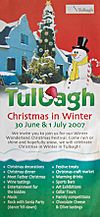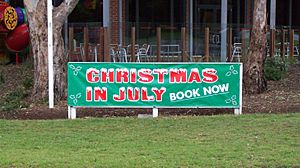Christmas in July facts for kids
Christmas in July is a fun, extra Christmas celebration. It usually happens in July, but sometimes in June or August. People enjoy Christmas-themed activities like small parties, holiday music, and shopping. The goal is to get everyone in the "Christmas spirit" during the summer in the Northern Hemisphere. It's also known as Christmas in Summer or Christmas in Winter.
Contents
Origins of Christmas in July
Have you ever wondered where the idea of Christmas in July came from? It's not a very old tradition, but it has some interesting beginnings!
Early Mentions
One of the first times "Christmas in July" was mentioned was in an 1892 French opera called Werther. In the story, some children are practicing a Christmas song in July. A character jokes, "When you sing Christmas in July, you rush the season." This shows that the idea of Christmas in summer was already a funny thought back then.
In 1935, a magazine called Recreation wrote about a girl's camp in North Carolina. They described a "Christmas in July" event there. It was a special, mysterious event for the campers.
Spreading the Idea
The idea of Christmas in July became more famous in 1940. This was when a Hollywood movie comedy titled Christmas in July was released. In the movie, a man thinks he has won a lot of money. He buys gifts for everyone and proposes to his girlfriend.
During World War II, Christmas in July became a way to help soldiers. In 1942, a church in Washington, D.C. held a "Christmas Presents in July" service. People brought gifts early so they could be sent to missions around the world. The U.S. Post Office and the military also used Christmas in July. In 1944, they had a lunch to encourage people to mail Christmas gifts early to soldiers overseas.
Since the 1950s, advertisers in the United States have used Christmas in July for sales. Stores often have "Christmas in July" sales to clear out old stock. TV channels might even show Christmas movies during July. Some people just use it as an excuse to have a fun party!
How Christmas in July is Celebrated
Christmas in July is celebrated differently depending on where you live.
Christmas in the Southern Hemisphere
In places like Australia, South Africa, Argentina, Brazil, and New Zealand, the seasons are opposite to the Northern Hemisphere. December is summer for them, and July is winter. So, a "Christmas in July" or Midwinter Christmas event lets them experience a Christmas with a cold, wintery feel, just like in the Northern Hemisphere. They still celebrate their main Christmas on December 25th, but these July events are a special bonus.
Christmas in the Northern Hemisphere
In the Northern Hemisphere, July is usually hot and sunny. So, celebrating Christmas in July is a bit of a joke! It's a fun way to bring the Christmas spirit to warmer weather. People might have parties with Santa Claus, ice cream, and gifts. Some nightclubs even host public Christmas in July parties. It's often celebrated on July 25th, but sometimes on July 12th.
Fun Ways to Celebrate in Summer
- The Hallmark Channel often shows its Christmas TV movies in July. This happens when their special Christmas ornaments are released in stores.
- The TV shopping channel QVC has "Christmas in July" sales. They sell decorations and early gift ideas. What used to be a 24-hour sale on July 25th is now a month-long event!
- Sometimes, stores have "Christmas in July" sales because there aren't many other holidays in July. This helps them sell products before the "back to school" shopping season starts in August.
Other Summer Christmas Celebrations
- Christmas in June: Some people celebrate a "Summer Christmas" on June 25th. This is exactly six months before or after the traditional Christmas. It started in Venice, Italy, as a way to celebrate love, friendship, and peace without waiting for a specific day.
- Jul i Juli in Denmark: In parts of Denmark, people might have small Christmas celebrations called 'Jul i Juli'. This name is a fun play on words, meaning 'Christmas in July'. It's not an official holiday, but some people enjoy it.
- Christmas in August in Yellowstone: In the 1950s, Yellowstone National Park started celebrating "Christmas in August". This might have begun as a way for park employees to extend their summer parties. Or it could have been to include a special music performance for visitors.
- Christmas in July in September: Some places, like Parker, Arizona, have celebrated "Christmas in July in September." In the Philippines, Christmas celebrations start very early. They unofficially begin in September and continue through the "ber" months (September, October, November, and December) until Epiphany in January.



